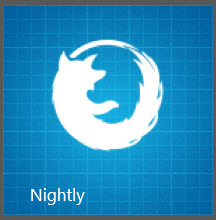Firefox for Windows 8 adds a touch of Metro style

Mozilla has released the first functioning version of its Metro-enabled Firefox browser for Windows 8. This is the public unveiling of a project that began almost a year ago.

The new browser isn’t ready for the public yet. Instead, you have to download it from the Nightly channel—the repository of bleeding-edge builds suitable for testing but not stable enough for full-time use.
The new Firefox joins Internet Explorer 10, which shipped with Windows 8, and Google Chrome, which released a Metro-enabled test version last June and pushed its Metro version into the stable channel late last year.
Internet Explorer 10 was the first example of a unique style of Windows 8 app that offers two views of the same browser engine: an immersive, plugin-free app (Metro style) and a traditional desktop program that supports Flash and other third-party plugins. The hybrid development model is available for browsers, but not for any other class of application.
Around the time of the launch of the Windows 8 Consumer Preview, Microsoft published a white paper, “Developing a Metro style enabled desktop browser,” with formal guidelines for developers and this definition:
A desktop browser that chooses to participate in the new Metro style experience when the user has expressed preference for the browser to do so. Such a browser can provide HTML5 rendering for webpages and service HTTP / HTTPS requests. By definition, such a browser has full access to Win32 APIs for rendering HTML5, including the ability to use multiple background processes, JIT compiling, and other distinctly browser-related functionality (like background downloading of files). Desktop browsers typically run at medium or low integrity level.
Around the release of Windows 8, Microsoft updated that document to remove the banned "Metro" term. The current release of the developer guidelines is titled "Developing a new experience enabled Desktop Browser."
I’ve installed the new Firefox Nightly build on a couple of touch-enabled Windows 8 PCs, including a Surface Pro running at full HD resolution.
Give Mozilla credit for embracing the Windows 8 interface. The Metro version uses the App bar (available with a right-click or a swipe from the top or bottom of a touchscreen device), and the tabbed browsing interface is also hidden until you reveal them with a swipe.
The interface offers minimal options, in keeping with the Windows 8 Modern UI design guidelines. For the full set of browsing options, you need to go to the desktop version.
Mozilla's design is a big differentiator from Google, which has basically ported its desktop browser to the Metro environment so that it runs in a full screen, with almost as many options as the desktop equivalent.
Firefox for Metro works fine in snapped mode and includes the ability to pin pages to the Start screen.
My biggest disappointment with this version of Firefox is its poor support for touch. On two systems, I was unable to use the pinch gesture to zoom the content of a page in Metro mode. Ironically, the same gesture worked just fine on the desktop.
I also couldn't select text on a web page, and the Share charm didn't connect this browser to other Metro-style apps.
Those issues can and will be fixed, but they make the browser less useful on a touchscreen device for now.
If you want to test the new Firefox on a Windows 8 PC, download the latest version from the Nightly channel and install it. (Sorry, Metro-enabled browsers don’t work on Windows RT.) To use the full-screen, plugin-free Metro version, set Nightly as the default browser and look for its oversize icon on the Start screen.